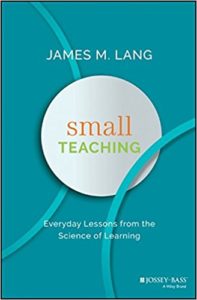by Dr. John Draeger, SUNY Buffalo State

The Association of American Colleges and Universities (AAC&U) has identified a number of high-impact learning practices (e.g., undergraduate research, collaborative assignments, learning communities, service learning, study abroad, capstone seminars). Each of these learning practices involve a significant investment of student effort over time with multiple interactions between faculty and students about substantive matters as well as frequent,constructive feedback from faculty, and regular, structured processes for reflection and integration (Kuh 2008; Kilgo, Sheets & Pascarella 2015). This post offers some strategies for intentionally structuring undergraduate research experiences and building metacognition into the process. Subsequent posts will consider other high-impact practices (HIPs).
Undergraduate research is a HIP because students ask the questions and set the research agenda. Inquiry-based projects, such as undergraduate research, promote student autonomy, self-direction, and teach students about the process (Healey & Jenkins 2009; Kilgo & Pascarella 2016). Without guidance, however, students can find themselves in a hot mess. After years of mentoring undergraduate research projects in philosophy, I’ve developed the following model to help keep students on track. Elements of this model may seem obvious and common practice. I don’t claim that it is novel, but I offer it as a distillation of some lessons that I’ve learned the hard way.
First, philosophers like to ask the big questions (and they should), but unless topics are reined in, student research can easily turn to sprawl and sloppy thinking. Thus, I talk with students about topic refinement early and often. I begin student meetings by asking them to give a one-minute “elevator pitch” for their topic. As the topic gets refined, the pitch becomes easier. En route to refining the topic and developing the elevator pitch, I ask a series of critical questions about the underlying conceptual issues. For example, if a student wants to consider what parents owe their children, I will push her to consider the nature of obligation (e.g., human rights, fairness, well-being, character, social roles) and concrete cases that may or may not fall within the scope of that obligation (e.g., providing food, a new bike, college tuition). Prodding them to consider the nature and scope of the obligation prompts them to consider the underlying philosophical substructure, which is what I believe philosophical inquiry is all about (Draeger 2014). However, once students begin making deep conceptual connections, it is easy for a topic to sprawl as students believe that each connected idea will need its own separate discussion. Metacognition encourages students to be aware of their own learning process (e.g., research) and make intentional adjustments based on that awareness. Encouraging students to be aware of the possibility topic sprawl can help them better evaluate whether their current thinking is moving away from the core issue or towards a better version of that core issue.
Second, all of us are standing on the shoulders of giants. It is good scholarship to acknowledge the original thinking efforts of others by using proper citation. However, the research experience should teach students more than to not plagiarize. Rather, undergraduate research allows students the opportunity to become co-inquirers within an existing scholarly conversation. Becoming familiar with the literature allows them to tap into long-standing debates and utilize conceptual distinctions developed by others. As students begin their research, each comes with their own background and dispositions. Some believe they need to read everything on a topic before they venture an opinion. Others are so eager to begin that they skip the literature review and soon find themselves lost without the resources found within the tradition. Metacognition can help students become aware of when they are reading too much or too little as well as point the way to adjustments in their process.
Third, many students struggle with how to find the relevant source material in philosophy. Even if they know how to use the library, they are often unfamiliar with idiosyncrasies of philosophy as a discipline. For this reason, I explicitly discuss how to go about doing library work (e.g., how to use library databases, how to conduct keyword searches, how to decide which articles seem promising), discuss reading strategies (e.g., how to read at different speeds to find articles most deserving attention, how to read identified articles more carefully, how to annotate a text with an eye towards research), and discuss note taking strategies (e.g., how to organize summaries, critical questions, conceptual applications, personal reflections). When undergraduate research is embedded in my course, we discuss these strategies in class. When undergraduate research takes the form of an independent project, I discuss these strategies one-on-one. In either case, I encourage students to practice becoming aware of what’s working, what’s not, and when they need to adjust their strategies.
Fourth, my undergraduate research students are required to keep a weekly journal. Students are asked to track pesky questions, troublesome counter-examples, and worrisome objections. Beyond their focus on content, however, students are also asked to focus on their own process, including a sketch of the library, reading, and writing strategies attempted as well as whether those strategies were successful. Journaling about these strategies is another way to encourage metacognitive awareness about the research process and locate opportunities for intentional self-regulation.
Undergraduate research can be a HIP (if implemented well) because it encourages students to learn about the research process on their own terms as well as producing their own research product. Metacognition helps monitor whether students are engaged in the sort of deep learning that makes undergraduate research a HIP. Moreover, intentionally structuring metacognitive opportunities can encourage greater learner autonomy and help facilitate inquiry-based research long after undergraduate experiences have officially concluded. In this way, undergraduate research and metacognition can be highly-impactful because they support the skills necessary for lifelong learning.
References
Draeger, J. (posted July 11, 2014). Using metacognition to uncover the substructure of moral issues.” Retrieved from https://www.improvewithmetacognition.com.
Healey, M., & Jenkins, A. (2009). Developing undergraduate research and inquiry. York: HE Academy.
Kilgo, C. A., Sheets, J. K. E., & Pascarella, E. T. (2015). The link between high-impact practices and student learning: Some longitudinal evidence. Higher Education, 69(4), 509-525.
Kilgo, C. A., & Pascarella, E. T. (2016). Does independent research with a faculty member enhance four-year graduation and graduate/professional degree plans? Convergent results with different analytical methods. Higher Education, 71(4), 575-592.
Kuh, G. D. (2008). Excerpt from high-impact educational practices: What they are, who has access to them, and why they matter. Association of American Colleges and Universities.





















